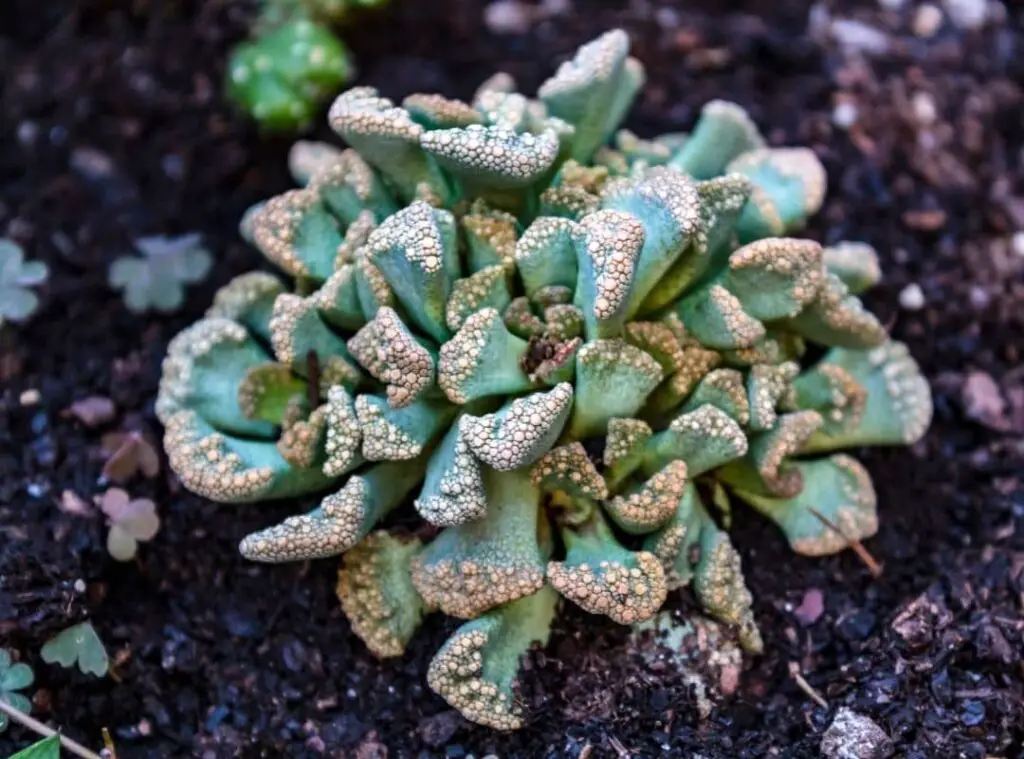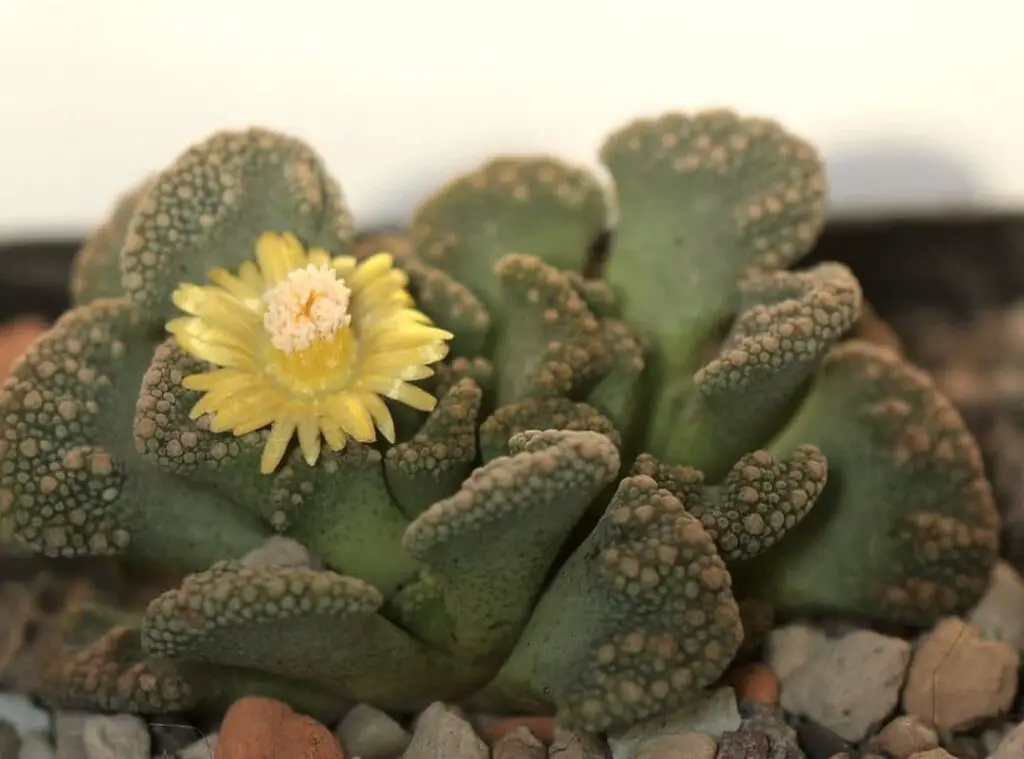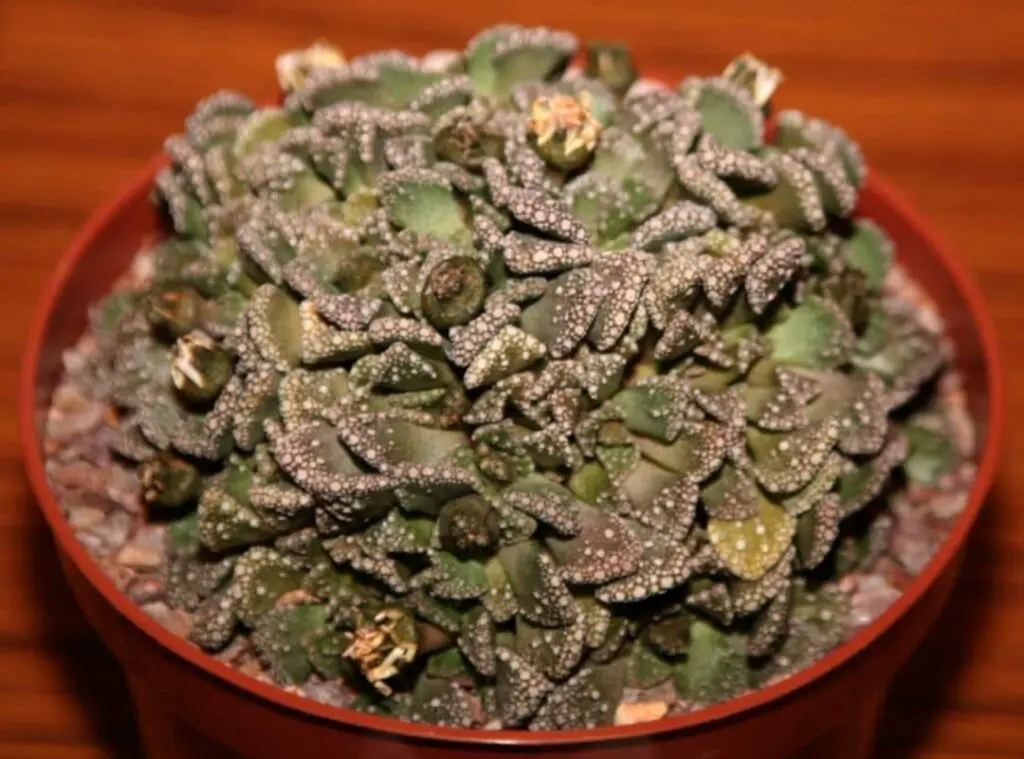Titanopsis calcarea are yet another glamorous plants which go by the name concrete leaf or jewel plant. Titanopsis calcarea plants are wild looking plants and they grow in clumps.
They are endemic plants to South Africa and Namibia. You could commonly find them in rocky habitats in these regions.
These are flowering plants and they can thrive well with minimum supervision from you. These are such great cute looking little plants.
You could spot them forming in different colors and many people are fans of the lovely grayish look they have.
I am going to cover how to look after these plants well and the right growing conditions you need to provide them. So, if you are excited to discover these beauties, I suggest you go through this article.

How do I identify Titanopsis calcarea?
Titanopsis calcarea plants grow in clumps. Furthermore, Titanopsis calcarea leaves would be blue-green colored.
Besides, they would tend to take a club shape. They would further come with white warts. They produce flowers which are showy.
Moreover, Titanopsis calcarea plants would be yellow to orange in color. Their flowering season would be in fall and in winter.
The sizes of the flowers would be 2 cm. The Titanopsis calcarea blooms would be funnel-shaped.
They consist of numerous stamens with narrowly elongated petals. On top of that they carry a fragrance of honey too.
Titanopsis calcarea blooms usually arise in the evening. Titanopsis calcarea are mat-forming plants and their rosettes would be about 8 cm ( 3 inches ) in width.
Furthermore, their leaves would be about 2.5 cm in length, and they will further comprise a truncate tip as well.
They may form in various colored leaves as well. However, the commonly spotted color would be gray or blue green. The fruits of the Titanopsis calcarea plants would be dry and would come in a brown capsule.
Size of the plant
Titanopsis calcarea rosette would be 8 cm ( 3 inches ) in size. Furthermore, their individual leaves would be 2.5 cm in length.
Growth rate
Titanopsis calcarea plants are not the types of plants which grow rapidly.
One look care guide
| Botanical Name | Titanopsis calcarea |
| Common Name | Autumn winter |
| Plant Type | Succulent |
| Mature Size | Rosette would be 8 cm ( 3 inches ) in width |
| Sun Exposure | Full sunlight or indirect sunlight |
| Soil Type | Well-draining |
| Soil pH | alkaline |
| Bloom Time | Autumn / Spring |
| Flower Color | Yellow |
| Hardiness Zones | Zone 10 ( 30 degrees Fahrenheit). |
| Native Area | South Africa and to Namibia |
| Toxicity | Non Toxic |
| Average price | $ 30 |
How do you take care of Titanopsis calcarea?
Light Requirement
There are certain disputes over the light requirement of the Titanopsis calcarea plants as some states that they do want full sunlight right throughout the year.
On the other hand, there are some people who say that they can survive with indirect bright sunlight and not with the bright full sunlight.
However, what I recommend you do is to expose the plants to bright indirect sunlight at first and then slowly expose them to full sunlight slowly.
I recommend you start it off by exposing them to morning full sunlight first as it is not that intense when compared to midday sunrise.
In case if the plants come across any scorching in the plants, you can place them in a shady place. Ensure that you fulfill the sunlight requirement of these plants as it will enable the plants to become vibrant in the colors.
If you fail to expose them to proper sunlight, they will tend to lose the usual blue gray green color and instead they will tend to take a greener look.

Temperature and humidity.
In terms of the humidity, low humidity levels would work well with them. If there are high humidity levels available, it will make the plants more prone towards root rot.
A temperature range around 45 degrees Fahrenheit ( 7 degrees Celsius) would work well with these plants.
Is it cold hardy?
USDA Hardiness Zone
Watering Requirement
Titanopsis calcarea plants can thrive with minimum water. They prefer to stay dry and if you water them in excess it will create root rot.
There will be less severe repercussions from under watering than over watering. Moreover, always ensure that you water the plants deeply.
If you are using tap water for them, you need to leave them in the watering can for at least one day so that all the chemicals will evaporate.
Besides, do not splash water on the plant’s leaves. If you mistakenly do so, there will be water trapped in the rosette and it will lead to root rot.
Further, the ideal time to water the plants would be in the morning so that it will allow the plants to dry out before they expose for cooler evening temperatures.
If you come across a situation where the leaves get floppy or become translucent , it literally means the plants are overwatered and you need to cut back on watering.
Soil Requirement Type / ph.
Titanopsis calcarea plants perform well if you grow them in a potting medium which is well-draining. To fulfill that, you can make a perfect soil mix by mixing universal soil mix and coarse sand and perlite.
Instead, you may add expanded clay as well. When you add these elements , the draining of the pot would be benefitted.
Moreover, you can grow them in a soil mix which is specifically made for succulents and cactus as they also have a fast drainage. You can easily acquire them from the garden stores.
Pot size Potting and Repotting.
It is vital that you provide a porous pot to grow the Titanopsis calcarea plants. Hence a terracotta pot or an unglazed clay pot would do.
The purpose of growing them in porous material pots is that the excess moisture remaining in the pot will evaporate rapidly.
When it comes to repotting, you do not need to repot them on a frequent basis as these are slow growers.
Hence, they can survive in the same pot for so many years. Furthermore, it would be better if you could repot the plants once you freshly purchase them from the stores.
You could do the transplanting during spring as it would be the best time to conduct the repotting.
Where to Plant
Ensure the place you selected to plant them is a place where they can gain sufficient sunlight levels.
As mentioned above, it is important that you let them gain sufficient sunlight as only then they thrive well.
Additionally, if you grow them as houseplants, ensure that you stick to aforesaid guidelines with regards to the potting mix and the pot.
Flowers
Titanopsis calcarea plants bloom in yellow and they will be funnel shaped. They flower in late fall and in winter.
These plants love cooler seasons like winter and autumn. The flowers will first make their first appearance during autumn. After that if you are lucky enough, you will see those flowers forming in winter also.

Fertilizer and time of year.
You may use a succulent fertilizer to feed the Titanopsis calcarea plants and use them in spring. .Furthermore, you can give a second dose of fertilizer for them during autumn.
Dormancy
Titanopsis calcarea plants go dormant when there are too warmer temperatures or cooler temperatures.
Winter
Titanopsis calcarea plants do not prefer to have wet roots during colder temperatures. Hence, refrain from watering them. Having said that, do not let them become bone dry also. Consider watering them on an occasional basis.
Summer
You can easily deal with the Titanopsis calcarea plants when they are dormant in summer. However, never leave them exposed to intense direct sunlight during summer.
You need to water them moderately during summer as they could dry out much faster during summer. If you end up over watering during summer it could also contribute to rot in the plants.
Toxicity
Titanopsis calcarea plants are nontoxic plants.
Common bugs and illnesses
Titanopsis calcarea plants generally resist diseases and bugs attacks. Having said that, If you had watered them in abundance, it would lead to root rot.
Additionally chances are that they may come across aphids attacks particularly when they are flowering.
Special Care tips
As aforesaid these are not the types of plants which grow rapidly and enormously.
Hence you do not have to prune them. All you need to do is to look after them well and provide the basic growing conditions.
Titanopsis calcarea benefits
Titanopsis calcarea plants are useful as ornamental plants. Besides, you can grow them as indoor plants and as container plants as well.

How to propagate Titanopsis calcarea
You can use the seeds of the Titanopsis calcarea plants to propagate them. You need to conduct propagation during spring as then the results would be guaranteed.
To propagate you need to first wet the seed compound and then sow. After that you can place the specimen in a bright, shady moist place.
Those conditions would be optimal for the germination process. Ideally you need to keep the seeds in the seedbed until they produce at least a couple of leaves. Next you may place them in individual pots.
Besides the seed’s propagation method, you can consider using the division method to propagate them.
When you spot the new clusters have grown significantly , you can propagate them. Ideally only then they can produce roots on their own.
Finally
Before wrapping this up, I hope you could improve your knowledge on growing the Titanopsis calcarea plants well and on the propagation methods as well.
As mentioned in the above, Titanopsis calcarea plants are an interesting set of plants which would flourish well if you look after them well.
Read Next : Graptoveria Titubans | Amazing Porcelain Plant Care | Hildewintera Aureispina | Majestic And Beautiful Cactus | Kalanchoe Humilis | A Kalanchoe With Tiger Like Markings |


